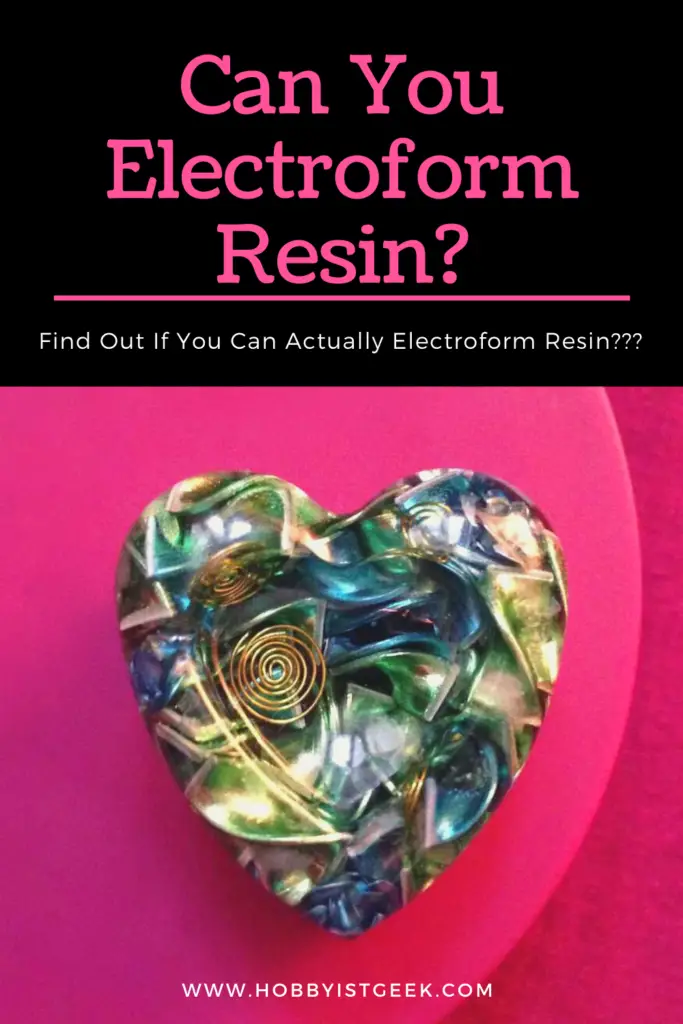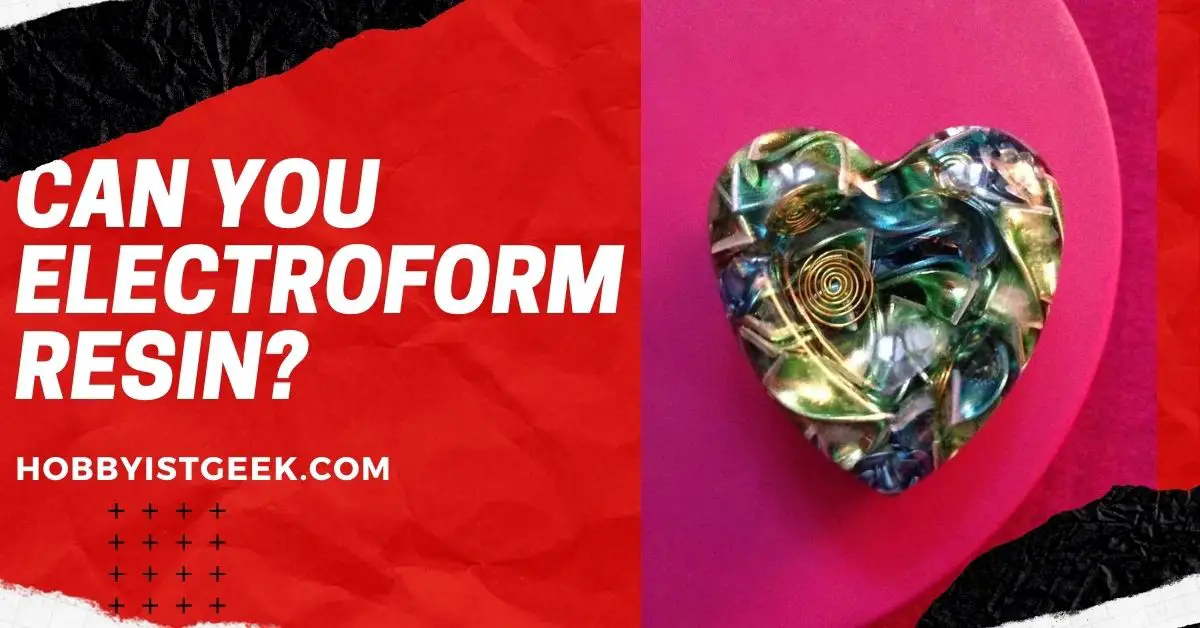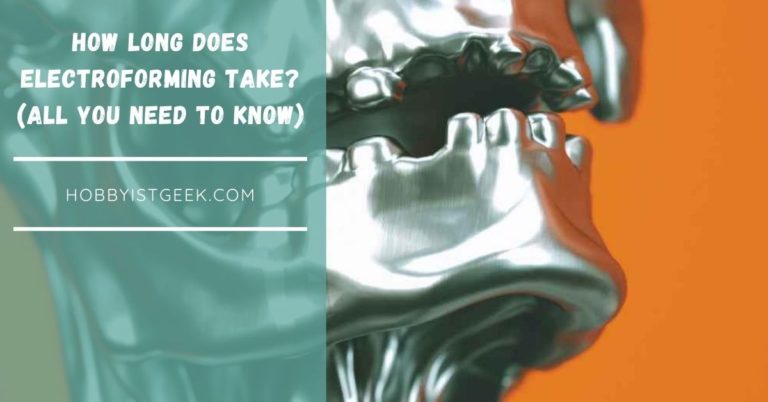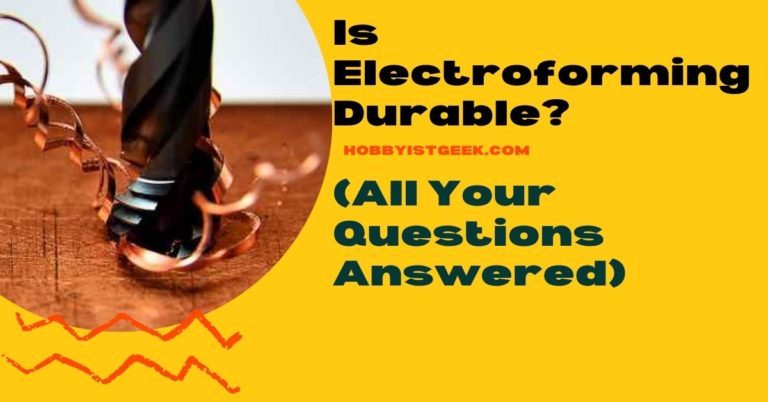Can You Electroform Resin?
Can You Electroform Resin? I will cover the art of electroforming and the art of resin the two very different, yet very similar creative arts.
They both form the process of creating beautiful projects, where the sky truly is the limit, but have you ever wondered what would happen if these two arts were to combine their powers?
The possibilities would be endless, no more just sticking to pre-existing objects to electroform, and no more sticking to non-metal materials for resin casting!
Create what your mind desires, sounds great, but how?
In this article we’ll walk you through the process from the resin casting to the electroforming, leaving endless possibilities and stunning results!
Let’s start by answering the question…
Can you electroform resin?
Here is the answer to the question Can You Electroform Resin?
In short, yes, you can electroform resin.
Resin can be cast into pretty much every desirable shape using molds.
After that the resin piece can be used as a core, we can then apply our regular electroforming techniques, with a few extra steps such as graphite painting, sealing, conductive painting, finishing, etc.
The possibilities are endless, and the final results are stunning!
That sounds great, with endless possibilities and great results!
Almost too good to be true perhaps.
There are quite a few steps involved in making molds, casting the resin, etc., and of course the electroforming process itself.
This can be quite a daunting task, especially if you’re trying to elevate your skills to the next level.
No need to worry though! In this article, we’ll guide you through the process and teach you all the ins and outs of electroforming with resin!
Let’s jump straight into it!
Can You Electroform Resin?
We’ve already shortly covered this question in the introduction, and yes, you can electroform resin! In fact, electroforming resin can be seen as the perfect project to further advance your electroforming skills to the next level.
This is because electroforming resin requires a few extra steps compared to regular electroforming, most noteworthy the casting and creating of your resin piece, but more on that later.
So, whilst electroforming resin might require a little more skill than electroforming pre-made objects, it’s more than worth the hustle!
The possibility to create your own pieces using resin, and then coating them with copper, you can then later use a technique known as electroplating to apply finishes in your favorite metal form such as gold or silver!
This leaves truly amazing results. It also creates endless opportunities for things like jewelry creation, or decorative elements for example.

Is It Easy To Electroform Resin?
In this paragraph we’ll cover another short frequently asked question related to electroforming resin, namely “Is it easy to electroform resin?”.
This is obviously a very subjective question, as different people can give different definitions of the word “easy”, but generally speaking electroforming resin is considered a little more difficult than electroforming regular objects, this is because of the extra steps that you’re required to take when electroforming resin, obviously most notably creating your resin piece!
However, don’t let any of this scare you away from attempting to electroform resin!
Every learning process requires trial and error, and there’s plenty of information to find to help you along the way, such as this article.
Learning how to create and use resin molds is a valuable experience, and the results will more than reflect the efforts you put into it!
If you’re up for a little challenge, and you want to improve you electroforming skills, and widen your art skills in general, then making an attempt at tackling a resin electroforming project might be perfect for you!
What Tools Are Required To Electroform Resin?
In this paragraph, we’re going to look at all the tools that we’ll need to create our resin piece, that’ll function as the core of our final electroformed result.
There’s a lot of tools and equipment that we’ll need to create our resin piece, this list is excluding the tools that you’ll need for the electroforming process, as you should be familiar with that process by now, if not we’ve got more beginner friendly articles we recommend you take a look at!
In this example we’ll use an existing object to base our mold on, in the paragraph on “Can you make your own resin molds?” we go into detail on creating your own creative molds!
Without further ado, let’s jump straight into the long list of equipment we’ll need for our resin casting!
First of all, you’ll need something to base your mold on, this can be anything from a phone case to a marble for example, after that you’ll need to get some modeling clay to make the mold.
Then you’ll need some silicon rubber and mixing cups, it is recommended to get different sizes of mixing cups as this will make it easier later on!
We’ll obviously need the main ingredient of the process, our desired casting resin, to work with.
We’ll also need a substance known as mold release, to do as the name suggests, release our piece from the mold later on!
We’ve now covered the most difficult items on this list, we’re left with a few more household items that we’ll need, such as popsicle sticks, razor blades, masking tape, tweezers, and rubber bands!
We’ll also need some small paintbrushes, a rolling pin, and a foam board! Wow, that was a long list, but we should be all set to get to work on casting our resin now!
Don’t worry about the use of the items just yet, we’ll cover how to use these items for the entire casting process in the next paragraph! I
n case this list overwhelmed you, here’s a link to an easy reference list of the items and their use: https://medium.com/jaycon-systems/the-complete-guide-to-diy-molding-resin-casting-4921301873ad
How Do You Electroform With Resin?
In this paragraph, we’ll look at how to use the, seemingly random, items mentioned in the previous paragraph to make our beautiful resin pieces, to form the core of our electroforming project!
We’ll do this in a series of four steps, starting by preparing our object!
This object will be used to create our mold, but before we can use it, we’ll need to prepare it.
We must start by taking a chunk of clay, make sure it’s bigger than the object we’re working with!
Knead the clay, form a ball, and then use the rolling pin to flatten the ball into a pancake like shape.
Place the object to be molded in the middle of the clay, then use a round object to create holes around the object, and larger diameter holes further away from the edges, this is done to prevent the mold from moving during the later phases!
Now we’ll need to add borders around our object, for this we use our foam board, make sure to leave around 1 inch of room between the edge and the piece.
Now use this box to cut around the excess pieces of clay and make sure the clay, with the object in it, fits snugly inside the foam box.
Add something conical, like a pencil point, to create key holes to properly align the two halves of the mold later on.
Then, place some clay around the edges of the box to tightly secure it in place. With our box now prepared, it’s time to pour our mold.
First, we mix our silicone material, in this scenario we use a 1:1 mixture, meaning 50% is part A and 50% is part B, make sure to mix them well.
For the first half, estimate the volume, and pour the silicone to just over the object, then use your small paint brush to ‘paint’ the silicone over the object, doing this prevents the formation of any air bubbles!
Now let it sit for the required time to dry, this time is usually indicated on the packaging of the purchased silicone.
In order to make the second part of our mold, we’ll need to flip the box and remove the bottom layer of clay, make sure to not move the object itself during this process!
If this is done correctly the previously made silicon should now be exposed, apply multiple layers of mold release to prevent the two halves from sticking together.
Now, repeat the silicone pouring process from before and separate the two halves, voila, we just made our mold!
After creating our mold it’s time to make some magic happen, we do this by casting our piece into the mold!
The hard part is already over, as casting our piece might be easier than you think. Place the two halves of your mold together and secure them using rubber bands.
Mix your resin, and then slowly pour it into the hole in the mold, doing this slowly is important to allow the time for air to escape the mold, preventing air bubbles.
If you want your resin to be a specific color, which in our case won’t be necessary since we’re going to electroform it anyway, now is the time to add coloring.
After casting, lightly tap the mold to remove any air bubbles that might have formed.
Let the resin sit in the mold for the required time before carefully separating the two halves, after separation you should be left with a beautifully casted resin piece!
Now all that remains before we can start electroforming is to clean our newly casted resin part.
Carefully remove any excess silicone or resin using our razor blade.
You can then lightly sand down your piece to perfectly match your original object, and there you go, a beautiful resin part ready for electroforming!
For more information and clarity on the process here’s a link to a full and detailed description: https://medium.com/jaycon-systems/the-complete-guide-to-diy-molding-resin-casting-4921301873ad
Can You Make Your Own Casting Resin Molds?
Great! We’re now able to create our own resin pieces to later use in our electroforming process!
However, this mold was still based on a pre-existing object, and thus our artistic freedom is still limited!
Can we change this? Yes, we can! In this paragraph we’ll teach you some easy ways for you to create your own special molds in no time!
Creating our own molds will truly allow us to set our creative minds free, with endless possible results!
As mentioned before resin molds can be created from many objects and it allows for easy duplication of that object.
Luckily there’s many ways for us to create that initial object from scratch! Depending on your personal expertise and budget you can use clay or wood to create an initial object.
If you’ve got a higher budget and a more professional goal, you can try using a 3d printer to achieve your goals!
If you don’t feel like spending time and money on a 3d printer, you can still look into 3d modeling on your computer as there are many 3d print services available throughout the world to deliver your designs.
Using any of these techniques allows us to open up even more possibilities!
What Problems Could You Run Into Electroforming Resin?
Obviously, electroforming resin isn’t a simple task and you might run into some trouble along the way.
To prevent this, or to help you fix some of your troubles, we’ll look at different issues you might encounter whilst electroforming resin.
In this article, we’ll focus on the resin part of electroforming resin, as we’ve got a separate article on troubleshooting electroforming specific tasks!
Let’s start with the most common, and most feared resin trouble, air bubbles.
A small air bubble somewhere won’t matter too much for us as we’re going to electroform over it anyway, but larger air bubbles can have some significant structural consequences.
Air bubbles can be prevented by using high-quality, fresh resin and not rushing the casting process.
Another resin issue that might occur are surface imperfections, surface imperfections, like bumps or dents, are caused by dust or larger particles entering the mold during the casting process, to prevent this, work in a well-ventilated room in a clean environment, away from any potential hazards for small particles!
If you follow these rules and are able to avoid these two primary issues you should be all set!
How Do You Use A Resin Core To Make Affordable Jewelry Using Electroforming And Electroplating?
Using resin as a base for many types of jewelry elements, such as beads or entire bracelets or rings for example allows for easy and cheap production of jewelry.
If you then pair this with the magic of electroforming, you’re left with an object that looks just like real gold or silver, this can be achieved by first electroforming your object using copper, and then later using a technique known as electroplating to apply a thin gold or silver layer to the object.
This opens up many possibilities in the jewelry business and how you design your own jewelry as using resin core products can significantly reduce production, and thus consumer, prices!
Besides the obvious price advantages, making resin core jewelry has more benefits you might not instantly think of.
Jewelry made using resin and electroforming is way lighter and therefore more comfortable to wear than regular jewelry.
The hard, and stiff resin core also prevents denting and makes the jewelry more resistant to little bumps and hits, that’ll inevitably occur when wearing them. In short resin, core jewelry might be the future of jewelry, as the advantages are massive!
What Are Electroforming Resin Ideas?
As we’ve mentioned multiple times throughout this article, combining the arts of electroforming and resin casting allows for infinite possibilities and it allows us to let our artistic minds run free!
However, sometimes this can become overwhelming and suddenly thinking of good ideas for your project can become rather difficult.
That’s why we’ve collected some inspiring ideas made using resin and electroforming to inspire you to get started!
First of all resin electroforming can be used to create amazingly creative jewelry pieces, in particular some very intriguing pendants like this creepy eye: https://www.pinterest.com/pin/411023903466476355/
Sticking with the jewelry aspect for this one, you can also create your own earrings, allowing for some beautiful resin based results like these ones: https://www.reddit.com/r/ResinCasting/comments/mapknx/some_earrings_i_made/?utm_source=share&utm_medium=web2x&context=3
Moving on to a little more creative and clever idea, electroformed resin stickers! Yes, you heard that right, stickers!
This leaves some amazing results that’ll allow you to stick your own amazing designs anywhere. An example: https://jttlogos.com/product/epoxy-resin-metal-sticker-custom-thick-electroforming-metal-sticker-fashion-shiny-colorful-metal-logo-sticker/
Final Thoughts For Can You Electroform Resin?
So, in conclusion, using resin as a core to your electroforming projects can open up new worlds in terms of creative freedom and possibilities.
It’s also a great way to evolve both your electroforming level and your resin casting to the next level. Thank you for reading my article Can You Electroform Resin? and good luck on your electroforming journey!
Electroforming: The Ultimate Guide Check It Out!
Sources In MLA Format:
“Electroformed Eye Pendant: Copper Work, Electroforming, Glass Art.” Pinterest, www.pinterest.com/pin/411023903466476355/.
“Epoxy Resin Metal Sticker Custom Thick Electroforming Metal Sticker Fashion Shiny Colorful Metal Logo Sticker – JTT: Professional Custom Metal Logo Stickers.” JTT, 23 June 2020, jttlogos.com/product/epoxy-resin-metal-sticker-custom-thick-electroforming-metal-sticker-fashion-shiny-colorful-metal-logo-sticker/.
“Epoxy Resin Troubleshooting.” ArtResin, www.artresin.com/blogs/artresin/18597325-artresin-troubleshooting.
Jane and SonjaJane and Sonja are sisters. “How to Make a Resin Mold.” Resin Crafts, 18 Mar. 2021, resincraftsblog.com/how-to-make-a-resin-mold/.
Jaycon Systems. “The Complete Guide to DIY Molding & Resin Casting.” Medium, Jaycon Systems, 16 Mar. 2017, medium.com/jaycon-systems/the-complete-guide-to-diy-molding-resin-casting-4921301873ad.
“r/ResinCasting – Some Earrings I Made!” Reddit, www.reddit.com/r/ResinCasting/comments/mapknx/some_earrings_i_made/?utm_source=share&utm_medium=web2x&context=3.
yvonne007bgu. “Electroforming on Resin.” YouTube, YouTube, 14 Dec. 2018, www.youtube.com/watch?app=desktop&v=LD-aaeXhqNM.
- Electroforming Conductive Paint, Where To Buy It, And How To Make It – The Ultimate Guide - April 24, 2021
- Copper Electroforming Solution Recipe - April 20, 2021
- Can You Electroform Polymer Clay? - April 13, 2021







